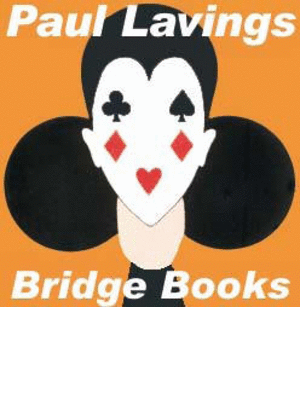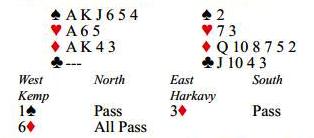Commonly Used Conventions
More Conventions
Source: ABF  By Paul Lavings paul@bridgegear.com
By Paul Lavings paul@bridgegear.com
Weak Jump Shift Responses are single jump responses to opening bids, such as 1![]() – 2
– 2![]() , 1
, 1![]() – 2
– 2![]() , etc.
, etc.
Written history traces the origin of WJRs back to 1934 when Harry Fishbein, by partnership agreement, jumped to 2![]() over his partner’s 1
over his partner’s 1![]() opening on
opening on ![]() Q975432,
Q975432, ![]() 94,
94, ![]() 82,
82, ![]() 73. In the 1950s and ‘60s a whole raft of revolutionary obstructive bids came into use, and by 1960 10% of the American Contract Bridge League’s 110,000 members played WJRs.
73. In the 1950s and ‘60s a whole raft of revolutionary obstructive bids came into use, and by 1960 10% of the American Contract Bridge League’s 110,000 members played WJRs.
My favourite bridge book, Psychological Strategy in Contract Bridge by FL Karpin (1960) gives this example of the constructive side of WJRs:

Nowadays an expert West would automatically rebid 7![]() , rather than settle for a mere small slam. At the other table 1
, rather than settle for a mere small slam. At the other table 1![]() was passed out, a huge gain for WJRs. Bergen Raises have replaced the WJRs to the three level, and the range is now 0-6 rather than 3-6. One disadvantage is that it is relatively rare, but nevertheless it came up twice at the recent Coffs Harbour Congress:
was passed out, a huge gain for WJRs. Bergen Raises have replaced the WJRs to the three level, and the range is now 0-6 rather than 3-6. One disadvantage is that it is relatively rare, but nevertheless it came up twice at the recent Coffs Harbour Congress:
South deals, EW vulnerable
The bidding was frequently something like:
Note that suit quality for a WJR is not a big consideration. 7![]() is a great spot for EW but from 76 tables one solitary pair bid 7
is a great spot for EW but from 76 tables one solitary pair bid 7![]() and only 10 bid 6
and only 10 bid 6![]() . 44 pairs bid to 4
. 44 pairs bid to 4![]() or 5
or 5![]() while 19 pairs sold out to various spade contracts, twice not doubled.
while 19 pairs sold out to various spade contracts, twice not doubled.
The second WJR was from the pairs. The point of the range of 0-6 is that there is no game opposite a balanced hand of 18-19 balanced and opener should not bid on:

As you can see, 4![]() is a long way from making 10 tricks. At two of the 63 tables, West was allowed to play 1
is a long way from making 10 tricks. At two of the 63 tables, West was allowed to play 1![]() for -50 (WJRs are indeed so infrequent that players sometimes forget they are available), and EW went all the way to the poor contract of 4
for -50 (WJRs are indeed so infrequent that players sometimes forget they are available), and EW went all the way to the poor contract of 4![]() an amazing 34 times, three times making. EW played 3
an amazing 34 times, three times making. EW played 3![]() four times and failed three of those four times. Only 14 times did EW stop in 2
four times and failed three of those four times. Only 14 times did EW stop in 2![]() for a plus score. The WJR is best when short in the suit opened, this is
for a plus score. The WJR is best when short in the suit opened, this is
a typical example of how the bid can gain:

West opens 1![]() , East jumps to 2
, East jumps to 2![]() and West passes. EW have nicely settled in their best spot, a 6-1 fi t at
and West passes. EW have nicely settled in their best spot, a 6-1 fi t at
the two-level.
Double-jumps after a minor suit opening to three of a suit are mostly played as splinters, but I recommend them as natural and attacking preemptive bids, depriving opponents of valuable space. They are still 0-6 HCP, but show a seven-card suit:
![]()
